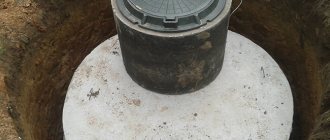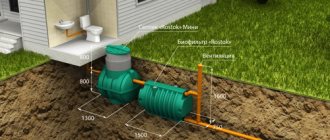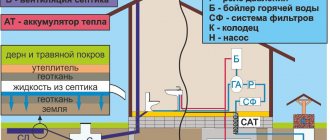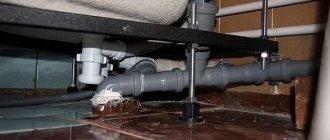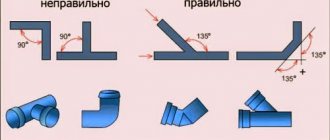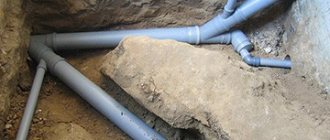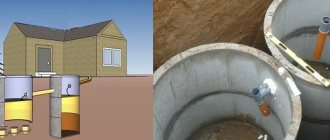When setting up a country house, the first thing that is done is the sewerage system.
The wastewater is discharged into a special container. Manufacturers offer a huge selection of these designs, but not everyone can afford to buy expensive equipment. A do-it-yourself overflow septic tank is a worthy alternative to a purchased storage tank.
A septic tank can be built from concrete or plastic rings, made from monolithic concrete, used in plastic barrels, or made of brick.
A septic tank with overflow is a storage tank for wastewater treatment consisting of two or more sections. Important! The more chambers, the higher the degree of water purification.
Ventilation
The installation of a ventilation system for the treatment plant is one of the key works. This is due to the performance of the following tasks by such a system:
- preventing the spread of unpleasant odors from wells and mains;
- protection against rarefaction of air in sewer pipes.
The technology for constructing this system comes down to connecting the waste pipe of the treatment plant to the ventilation riser, which is discharged onto the roof of the building. In this case, it is necessary to ensure that the riser pipe has at least the same diameter as the pipe with which the septic tank is connected to the facility’s sewer system. The most suitable value for the diameter of the waste pipe is 110 mm.
If the selected cross-section is small, then as a result of water drainage, the pipe lumen will be blocked. A piston effect will occur, due to which liquid will be sucked from the siphons of plumbing fixtures, against which the principle of the water seal will stop working. The most unpleasant thing here will be that odors from the sewer will begin to spread into the room.
What to pay attention to when cleaning a septic tank
The critical level of sediment is to increase its level to a distance of 25 cm from the lower edge of the drainage pipe. This can be easily calculated using a wooden strip directly inside the septic tank. You will have no problem determining the distance between the sediment and the runoff.
In this case, it is urgently necessary to use the services of vacuum cleaners.
Remember that you should not pump out the sediment to the zero mark, as you will disrupt the work of the microflora that you worked so hard to set up. It is optimal to leave 10-30% sediment for proper operation of the septic tank.
Ring cesspool
A cesspool made of concrete rings is a very popular solution for a country house.
Advantages:
- Durability (the well lasts up to 100 years).
- Concrete is not subject to rotting and tolerates the fermentation process well.
- Installation is simple and inexpensive.
- Groundwater is not polluted.
- Does not depend on soil type and groundwater level.
Stages of installation of a cesspool made of rings:
- A hole large enough for concrete rings is dug.
- The bottom is filled with concrete mortar. The proportions of crushed stone to cement are 6:1. The solution should harden within 7 days. If pouring occurs in hot weather, then the surface of the concrete must be periodically wetted, otherwise cracks will appear and the required strength will not be obtained.
- After the concrete has hardened, we begin installing the rings. You can't do it without a crane. Some sellers provide a rental service for lifting equipment. The rings are carefully lowered onto the concrete bottom. After installation, the seams are insulated using sealants (liquid glass, rubber-based seals). It is best to use liquid glass by mixing it with cement mortar and applying it to the joints between the rings. Internal insulation is quite sufficient, but if your site has a high groundwater level, then you need to carry out the operation from the outside. For ease of installation, buy rings that have a “lock”. When using conventional ones, the structure will have to be fastened with metal brackets.
- A concrete floor with a hole for a hatch is mounted on the top of the ring.
https://youtube.com/watch?v=kiT65mIE0p0
How to install a sump tank?
Consider the installation of a two-chamber septic tank. In the pit, the bottom is filled with sand to a depth of 100-150 mm and watered for the best shrinkage.
The next concrete ring is installed on a solution in proportions - 1 cement: 3 sand: 0.1 liquid glass. It is necessary to prepare the solution in small portions, since it must be used within half an hour.
1 — rings of the working part; 2 — insulating cover; 3 — neck rings; 4 — hatch body; 5 — hatch cover; 6 — ventilation riser; 7 - floor slab; 8 — bottom plate; 9 — crushed stone cushion; 10 - waterproofing; 11—sediment zone; 12 — running brackets
The cover with the hatch is installed on a bed of sand-cement mortar.
The sump requires waterproofing with two layers of hot bitumen or coating with a water-repellent composition.
How to make a cesspool with your own hands?
Place for a cesspool
This issue must be taken very seriously. There are special regulatory documents and established sanitary standards with the help of which the required location for a cesspool is selected. The requirements for the location of this device are as follows:
- The distance from the cesspool to the living space must be at least 12 meters.
- The distance from the cesspool to the fence must be at least 1 meter
- It is prohibited to build a drainage pit next to wells and wells with drinking water, the minimum distance should be 5 meters
- It is not recommended to build a hole near garden trees
- The location of the cesspool should be convenient for the access of a sewage truck
Sump size
First of all, the size of the cesspool depends on the number of residents and the structure of the soil. On average, the monthly water flow of a family of 3-4 people is 12-13 cubic meters, which means that the cesspool must have a volume of at least 18-20 cubic meters.
If the soil at your summer cottage easily allows liquid to pass through, you are allowed to make a minimum reserve of cesspool volume (40% of the monthly water flow).
If the soil of a summer cottage is clay or other rock that does not allow water to pass through easily, the volume of the cesspool should be equal to the monthly flow rate.
Construction of a cesspool
It is recommended to lay out the walls of the cesspool from brick, plastic, concrete or reinforced concrete rings. The simplest option is to finish the walls of the sewer pit with brick.
In order to lay the walls of the pit with bricks, you first need to calculate the amount of building materials. After this, the bottom is concreted (to eliminate problems associated with pumping out liquid) and the brick is laid. If you lay the bricks in a checkerboard pattern, you can “kill two birds with one stone”: save money on building materials and provide additional drainage of water into the ground.
Cesspool made of bricks laid out in a checkerboard pattern
Upon completion of the work, a ceiling or monolithic slab is installed. The installed ceiling must have a hatch for pumping out wastewater using a vacuum cleaner.
Brick cesspool
You can eliminate freezing of liquid in the pit by insulating the lid; to do this, make the top of the wall 30 cm below ground level, install a ceiling and cover it with earth, which will ensure heat retention.
How to prepare a pit?
When starting to prepare a pit, you should take into account the maximum permissible groundwater level. When installing filter wells, it must be at least 3 meters from the ground surface, when installing underground filtration fields and clay soils - 1.5 m.
When digging a hole for a future well, adhere to the principle: the soil moisture has increased at a decent depth - it’s time to finish. If the depth of the dug hole is less than 1 meter, then nothing will come of it and you will have to bury it.
In order to have good stability and prevent drainage of wastewater into the ground, the installation of a multi-chamber septic tank requires the fulfillment of the following conditions: all chambers, except the final one, must be installed on a concrete base.
The principle of operation of the design
The operating principle of a three-chamber septic tank.
Treatment facilities of this type are capable of filtering sewage up to 90–95%. The design of an overflow two-chamber septic tank is quite simple. The two tanks are connected to each other using plastic pipes.
There may be more containers, but a couple are enough for a small cottage. The first acts as a settling tank and reservoir for water-insoluble heavy dirt particles. It must have a hatch for the hose of the sewage disposal equipment, since such septic tanks still require pumping, although less often than just storage tanks.
Once in the second chamber, the clarified liquid is repeatedly settled and purified by bacterial flora, which feeds on organic matter and biowaste.
After cleaning in the second container, the liquid is sent to the filtration fields or to the infiltrator. It is also possible to install filter screens and grease traps in the overflow tube, which retain some of the dirt when the wastewater is overflowed from one container to another. Filtration devices contain bacteria that help decompose waste. When using an aerobic type of microorganisms, the structure is equipped with ventilation shafts or an aerator.
Features of the design of overflow septic tanks
If we consider the design of overflow septic tanks in general form, then these are two wells, the first of which serves for
settling solid fractions and carrying out the rotting process. It has a concrete bottom to prevent unwanted liquid drainage. The second of them, which has a bottom made of crushed stone, is filtering and absorbent. The liquid, which has already been pre-cleansed of large solid particles at the previous stage, undergoes resorption. The first well must be periodically cleaned, removing excess silt from there. This cannot be done manually; it is simply impossible to do without calling a special sewage disposal machine. However, in order to resort to its services as little as possible, biological products are added to the first well to help break down solid particles to the greatest extent possible.
Design advantages and disadvantages
The question of why an overflow septic tank is created can be answered with a list of the advantages that this design has. These include:
- safety for ecology, environment;
- high level of wastewater treatment;
- stability of operation during salvo discharges;
- the ability to record the territory in a convenient place (taking into account sanitary standards);
- no dependence on electricity;
- possibility of self-installation;
- low cost.
Among the disadvantages of such structures are the need for periodic cleaning of containers (especially the first one), as well as the appearance and spread of stench if operation is disrupted.
Ventilation methods
There are two types of cesspools:
Autonomous structure - septic tank. If the cesspool is located on a site next to the house, the unpleasant smell from the wastewater will certainly spread throughout the site. How to remove odor from a cesspool? When constructing a treatment plant, it is necessary to leave a hole in its lid for the ventilation pipe. The cross-sectional diameter of the pipe is from 10 cm. Most often, plastic pipes are used for ventilation - they are lightweight and easy to install. A second pipe with a diameter of 5 cm must be inserted into a pipe with a diameter of 10 cm.
The pipe is inserted into the septic tank, its lower end must be 30 cm higher than the maximum filling level of the pit. The height of the pipe must be higher than human height, so that unpleasant odors go up. The upper end of the pipe must be protected from water and snow, for example, with a special cap.
Such a simple structure is quite effective at eliminating odor. The higher the pipe, the higher the smell goes. It is not necessary to place the hole very far from the house, and the land next to the hole and above it can be used like any other: for beds or a lawn.
Cesspool under the toilet. An outdoor toilet is a common construction in summer cottages or in private homes. Even if there is a bathroom in the house, owners often arrange a toilet outside in case of problems with the sewage system.
Usually, an outdoor toilet is presented as a place with an unpleasant odor, located far from the house. Why does the smell appear? Waste accumulates in the pit under the toilet and releases methane gas. Gas rises. This is what creates the characteristic smell. There are known cases of methane poisoning and fires. In addition, under the influence of methane, wood, the main material for the construction of outdoor toilets, deteriorates faster.
Today there is a way to turn the usual idea around. An outdoor toilet can be located close to the house and not be a source of stench. When building a toilet, you must take care of ventilation, otherwise the smell will spread both in the toilet stall and around it.
There are two ways to install ventilation in an outdoor toilet:
1. Natural. Based on the natural laws of air movement.
2. Forced. Speeds up the process of removing contaminated air using a fan, therefore it is more effective. The air in the cabin will be perfectly clean. But its device requires electricity; it must first be wired to the booth in order to connect the fan. In addition, the organization of forced ventilation requires additional material costs - the purchase of a fan.
Both systems involve the installation of a supply opening, an exhaust duct, and an exhaust hood located above the cesspool. The easiest way to install ventilation is to install a pipe. The length of the pipe is approximately 3 meters, the diameter is from 11 cm. You need to make a hole in the lid above the pit behind the toilet.
The lower end of the pipe is inserted into this hole. If there is space left between the cover and the pipe, it must be sealed with sealant or filled with foam. The pipe is positioned vertically and secured to the back wall of the toilet with clamps. A protective umbrella cap is placed on the upper end of the pipe. The pipe must be at least 70 cm higher than the roof of the toilet.
Two openings must be provided in the toilet stall:
- Exhaust - located closer to the ceiling. It is usually cut out at the top of the door. With a natural ventilation system, it also performs a second function - a window. When installing forced ventilation, an exhaust fan is installed in the exhaust hole.
- Supply air - located in the lower part opposite the exhaust. To prevent mice from entering the booth, for example, a grille is installed on the inlet opening.
Ventilating a cesspool in a private house is a fairly simple matter and does not require much time or large material costs. At the same time, ventilation effectively eliminates odors and prevents premature destruction of the toilet stall.
The need for a ventilation system is usually not in doubt. But not everyone understands the functions performed by this system.
Sewage system in a private house
How to install a sewer system in a private house in order to immediately anticipate all the difficult moments:
- draw a sketch yourself;
- see if all conditions are met - pipe slopes, connection angles;
- calculate the length of pipes, the number of corrugated elements, adapters, crosses;
- determine places for cleaning pipes from blockages - usually such places are located before turning the pipes;
- outline street elements - wastewater pits.
Do-it-yourself sewer installation in a private house begins with the installation of vertical pipes. The closer to the toilet, the better. Ventilation is provided with access to the roof. The diameter is selected taking into account the throughput. If you need to connect a bathroom in which there are 5 - 6 water intake points at the same time, then the pipe must be at least 110 mm in diameter.
Rules for arranging a septic tank
To prevent wastewater from penetrating into the ground, the pit is insulated.
This could be a concrete structure made of rings, like a well, the bottom of which does not allow waste to enter the soil. You can lay a septic tank out of brick, but the brick will have to be plastered to prevent it from leaking. The most reliable are plastic or metal containers immersed in the ground to a depth of 2 meters. The container must be installed below the level to which the soil freezes in winter. It depends on the conditions of the region.
In what cases is the construction of a septic tank prohibited?
There are several requirements for the site where the construction of a sewer system is planned, non-compliance with which is not allowed. We list the conditions under which it is impossible to build a septic tank:
- coverage of the sanitary protection zone of water supply sources;
- subsidence or rocky soil;
- steep slope (can lead to landslides);
- excessively high groundwater level;
- impossibility of maintaining sanitary, construction or technological gaps between buildings and soil filtration structures.
Types of cesspools and arrangement rules
The cesspool should be placed on the site so that special equipment can drive up to it. Plus, the location of the well, if there is one, the depth of the flowing groundwater and the number of people living in the house are taken into account.
When classifying, the volume of the pit is determined from the frequency of use and design. That is, if living in a house is carried out seasonally, for example, in spring and summer, then a sump tank of the simplest design is sufficient. If accommodation is carried out on a permanent basis, then the design is selected from 3 types:
- drain (no bottom provided) - ideal for a bath;
- hermetically sealed – for large amounts of waste;
- storage septic tank - suitable for partial cleaning and drainage of wastewater.
Let's talk about the features of each type.
Drain
This is an absorption sump where the waste is cleaned by an earthen filter. Large volumes are not provided for the design. After installation for some time, the water drains without difficulty unless the soil is mixed with clay. Subsequently, sludge accumulates in the barrel, so the absorption structure must be cleaned.
The big disadvantage of such a pit is environmental pollution. The situation gets worse if the outlet is made from the toilet.
Sealed
Most often, a sealed cesspool is made of concrete rings, solid slabs or bricks. The big advantage is that a sealed cesspool is absolutely safe for the environment. The septic tank is cleaned by pumping out sewage using a special machine. It can be single-chamber, double-chamber, etc.
One of the disadvantages is the need for frequent waste pumping.
Cumulative
A storage septic tank can also consist of one or more chambers. The bottom must be laid out with broken bricks or crushed stone. That is, sewage does not come into contact with the soil and does not pollute groundwater.
The principle of operation of a septic tank is standard - after filling the tank, pumping is performed. The frequency of removal depends on the volume of the pit. For example, if a storage tank is installed at a dacha, where the owners come only on weekends, then the car is required no more than once a year.
Construction materials
In order to equip a high-quality sewer system with an overflow cesspool, it is necessary to prepare the necessary tools and materials in advance. Only at first glance it seems that it is impossible to build such a structure with your own hands.
In fact, there is nothing complicated about how to make a cesspool with an overflow; it is important to use good materials and follow the recommendations for arrangement
During the construction process, you can use both materials that you can find at home, as well as those purchased in advance. Often, overflow cesspools are made from car tires, red bricks or concrete rings. Since the pit consists of two chambers, they can be made of different materials.
You will also need crushed stone and sand to lay drainage at the bottom of the second tank; the first is filled with concrete. You should also stock up on tools that may be needed during the work process. This is a shovel, rope, bucket, hammer, chisel and other items that you probably have in your garage.
How to install a filter well?
An iron barrel is suitable as a filter well, which will save your budget.
The location of the filter base should be at a level exceeding 1 meter of groundwater level. Otherwise, the load goes up to 20%.
1 — water barrier; 2 — neck rings; 3 — hatch cover; 4 — insulating cover; 5 — hatch body; 6 - floor slab; 7 - ventilation riser; 8 — blind rings; 9 — perforated rings; 10 - filter media; 11 — holes in the rings; 12 — concrete base; 13 - supply pipeline
To increase the absorbent surface area, holes with a diameter of 60 mm and a total area of 10% need to be made on the walls of the well.
At the bottom you should lay out a layer (200-300 mm) of expanded clay, crushed stone and other small stones, which will serve as a filter.
We recommend reading the instructions for building a drainage well.
General information about septic tanks
What is the difference between a septic tank and a cesspool? A septic tank is a more modern and functional type of modern sewage system for private homes. This structure collects and purifies household wastewater from houses, cottages and dachas if there is no central sewage system. The difference between a septic tank and a cesspool is that it implements biological wastewater treatment. It settles sewage and purifies it using bio-enzyme preparations.
Various models purify wastewater by 90-95%. They use a natural biological method of purification through an anaerobic process. Large household fractions are converted into sludge. These designs are non-volatile and generally operate without electricity. Sludge is removed from septic tanks several times a year.
Distinctive features
Unlike a septic tank, a cesspool does not process household waste; it immediately goes into the ground. They can be broken down with chemicals or powders, but they are completely ineffective against organic matter. Because of this, harmful substances, unpleasant odors and poisons remain on the site. The cesspool requires regular pumping. The septic tank, in turn, completely recycles household waste thanks to the action of microbes.
Moreover, septic tanks use a natural biological method of treatment using an anaerobic process.
Which is better, a cesspool or a septic tank?
When choosing a septic tank or cesspool, you must pay attention to the evaluation and selection criteria. Pay attention to the features of your territory. If you have a large plot and a small number of people live in the house, and you come to the dacha only in the summer, then you can build a cesspool and pump it out at regular intervals
If you live in a country house for a long time, you need water to water the garden, and you don’t want there to be unpleasant odors outside, then opt for septic tanks
If you have a large plot and a small number of people live in the house, and you come to the dacha only in the summer, then you can build a cesspool and pump it out at regular intervals. If you live in a country house for a long time, you need water to water the garden, and you don’t want there to be unpleasant odors outside, then opt for septic tanks
Pay attention to the features of your territory. If you have a large plot and a small number of people live in the house, and you come to the dacha only in the summer, then you can build a cesspool and pump it out at regular intervals. If you live in a country house for a long time, you need water to water the garden, and you don’t want there to be unpleasant odors outside, then opt for septic tanks
If you live in a country house for a long time, you need water to water the garden, and you don’t want there to be unpleasant odors outside, then opt for septic tanks.
When choosing a septic tank, consider:
- What volume of wastewater can it process?
- How long will it function;
- How many cameras does it have?
If you decide to install a cesspool, be prepared for the fact that when it is completely filled with household waste, if you do not pump it out in time, there will be a smell of rot and flies in the area.
Popular septic tank models and types of cesspools
There are several options for pits:
- Absorbing (the bottom is not isolated from the soil, insoluble particles remain inside, it slowly fills with waste).
- Partially absorbent (this is a storage tank in which sealed walls are installed, but there is no sealed bottom).
- Sealed (this is the best option for a summer house, since it is the safest, but a sealed pit requires pumping out 2-3 times a month).
The choice of septic tank model depends on the number of chambers you need to process wastewater:
- If no more than 1 cubic meter of wastewater is generated in your house per day, a single-chamber septic tank is suitable.
- A two-chamber design is needed if the flow rate is 1-10 cubic meters of water.
- More than 10 cubic meters - you need a three-chamber model.
If a family lives at the dacha for a short period of time, storage units are suitable. These are reservoirs for storing wastewater. If a family lives in a house permanently, then an overflow-type structure is needed, in which wastewater not only accumulates, but is also purified
Pay attention to the following septic tanks: Chistok, Bars, Septic tank Evost
The simplest facility for the disposal of liquid household waste in the absence of a connection to
https://vivoz-gbo.ru
What is the difference between a septic tank without pumping?
What are the characteristic features of such a system? The answer lies in the operating principles. Wastewater undergoes a process of separation into liquid, which can subsequently be discharged into drainage, and solid components. It is solid waste that will eventually require pumping, but due to the fact that its volume will be much smaller, pumping can be carried out less often “no more than 6-9 years.” For subsequent disposal, waste coming from the sewer system of a country house requires separation - division into heterogeneous fractions. The use of special impurities in the process, which include enzymes, provides a significant increase in the service life of such a system, because thanks to the activity of organisms, aerobic and anaerobic bacteria, the sludge existing in the system is well processed into methane and carbon dioxide, which are discharged using a ventilation pipe mounted above the storage tank. According to the peculiarities of its design, a septic tank for a dacha without pumping is nothing more than a two-chamber waste disposal system, in other words, a two-chamber septic tank. The meaning of dividing one container into two chambers is as follows:
- sealed chamber - here the contaminated water entering the septic tank is received and settled without pumping directly from the house sewer system. Solid compounds settle and oily compounds rise to the surface. Due to this, the wastewater is partially purified and prepared for the next stage of treatment.
- second chamber - wastewater that has already undergone primary treatment enters here. Further disposal takes place naturally - the chamber has no bottom, therefore the liquid seeps into the soil through a special layer of gravel or crushed stone.
The huge demand for a septic tank for a dacha without pumping has led to the appearance on the market of a system with smaller dimensions, the so-called mini-septic tank. Such septic tanks for a dacha without pumping are budget versions of the usual ones that will allow installation of the system in fairly dense buildings, or in cases where the available area of the site is limited.
Septic tanks for summer cottages without pumping, budget treatment systems. A system with three chambers is not used so often, despite its greater efficiency, because the cost of such a system cannot be compared with a two-chamber septic tank. If the owner is concerned about the environmental side of the issue, then a treatment station will be the best solution. Such a station provides the highest possible level of purification; the water after treatment is suitable for watering and washing a car, and organic residues in the form of sludge are suitable as fertilizers. But there is also a significant disadvantage - such a system is energy dependent and requires expenses to maintain its functionality.
Septic tanks of our own production
Quite often, a cesspool is built with one’s own hands for a summer residence, as well as for a private house. The strength of this rather complex system is the ability to carry out deep waste treatment. At the same time, they are processed into fertilizer, which is then used to enrich the soil. The complex most often consists of two or three chambers. The first of them is intended for liquid accumulation and primary mechanical cleaning. After this, special bacteria come into play, which leads to complete recycling of hazardous waste.
Using the overflow principle in constructing a drainage pit in a private home allows you to achieve outstanding results. The water inside the system is purified so well that in the future it can be used for economic and technical purposes - watering the garden, washing surfaces and cleaning areas. Arranging a drainage pit with an overflow will require considerable financial and physical costs. Old car tires are often used for this (the main thing is that they do not have holes). Given the light weight of the rubber, the construction of a solid foundation in this case is not required. Usually a compacted cushion of crushed stone and sand 30-40 cm thick and a cement screed 10 cm high are installed.
Recommendations on how to equip a cesspool from homemade septic tanks:
- A good way to increase the volume of a tank constructed from tires is to cut off their sidewalls.
- A concrete pipe is installed inside the finished tire trunk in a strictly vertical position. A building level is used for this. It is desirable that it be 2 times smaller in diameter than the tire size.
- The pipe is mounted so that its upper cut is 10 cm below the mouth of the rubber well.
- Concrete is used to fill the bottom of the pipe. As a result, you need to get a monolithic concrete cylinder. It is equipped with a hole at the top for infiltration and for an overflow pipe.
- The sewer pipe is inserted into the container. Areas where the vertical and sewer pipes are connected to each other must be sealed.
General information
A storage device with several compartments can be of three types
- Two sections, where the second is a drainage well. Not all wastewater is allowed into such a septic tank. And it is not recommended to install it for a home with a large family. A good option for a summer house or a small house where 1-2 people live permanently.
- Two chambers and a post-treatment system. This design can be assembled for almost any home. But the number of permanent residents should not exceed 8 people.
- Septic tanks of 2-3 chambers with a post-treatment system, working with a biofilter. If you want to preserve the environment, save on sewerage systems and practically forget about the storage tank, then this option is ideal.
In order to build a septic tank, you need to choose a location.
Installation norms and rules
According to SNiP there is an acceptable minimum distance to certain objects
- 5 m to a residential building
- 3m. to the trees
- 10m. to a river or stream
- 30m. to a well or borehole
- 50m. to a lake or any other large body of water
- 5m. to the road
Volume calculation
After the installation location has been determined, the volume of the septic tank should be determined. According to SNiP statistics, one person uses 200 liters of water per day. There is a difference between the volume of a conventional septic tank and a septic tank with a biofilter. For a conventional drive, the calculation formula is as follows:
200l. * for the number of residents + 1/3 of the resulting volume.
It is better to round the number up. For a family of 5 people you will need a septic tank with a volume of 1400 liters. If the sewer storage tank has a biofilter, then the volume should be increased not by 1/3, but at least 2 times.
The fact is that bacteria take a certain time to work. According to SNiP, water must be treated in this way for 14 days. Multiplying 1000l (5 people) by 14 is at least not reasonable. The result will be a septic tank that is too large, and there will be no water consumption in such an amount.
Making a septic tank of 2500 - 3000 liters is more than enough.
After calculating the volume and choosing the installation location, you can begin installation.
Typical reinforced concrete sewer well
A standard design of reinforced concrete sewer wells, depending on their purpose, was developed back in 1984 by the Central Scientific Research Institute for Standard and Experimental Design.
It is the last album that is of interest to us. It presents calculated data for most types of wells that are of interest to owners of suburban areas.
Such information is truly invaluable for a master who has decided to independently build both a septic tank from reinforced concrete rings and an ordinary well responsible for the water supply of the site.
Components
The struggle for the unification and manufacturability of manufactured products has led to the fact that the “assembled” reinforced concrete well has at least five structural elements:
- concrete rings, the main ones, making up the frame of the entire structure;
- rings are dimensional, additional, with a height of 10 to 30 centimeters. Used to accurately select the required well height;
- concrete base or bottom. Depending on the manufacturer, it can be either reinforced concrete or simply concrete. Such liberties in manufacturing are allowed, since this element does not bear significant mechanical loads;
- well neck with hatch. It is used when using reinforced concrete rings with a diameter of two meters and above;
- reinforced concrete slab, with a hatch, for wells of “normal” sizes.
The combination of the above elements makes it possible to bring to life the most daring plans of a novice “homemade artist”.
Assembly of well elements
As a rule, it takes place in a pre-prepared pit and begins with preparing the base for the first ring. Reinforced concrete structures are installed one on top of the other and fastened together with a Euro-lock (grooves of a certain shape) or brackets made of steel reinforcement, with a diameter of 10-20 millimeters.
This operation is necessary to increase the stability of the well shaft to possible displacements of soil layers, the so-called “quicksands”. The concrete bottom, with a diameter slightly smaller than the reinforced concrete ring, is laid in the next line.
All that remains is to seal the seams using special mortars.
Preparation for construction of the structure
For the pit, a site is selected at a distance of at least 20 meters from the nearest water intake point and at least 10 meters from the building. The groundwater level should not be high. The liquid in the receiver should be located below the freezing layer of the ground.
Each drain is positioned to each other at an angle of up to 20 degrees. Their connection is made with pipes in the shape of the letter T. These fitting elements are installed at a distance of at least a meter from the uppermost part of the tank.
The volume of each tank is at least two cubic meters. It is calculated depending on the total number of occupants and plumbing fixtures. The more there are, the wider and deeper the cleaning chambers will be required.
Construction of a cesspool with overflow
Most often, these installations consist of two chambers, which are connected at a certain slope by a special pipe. In the first chamber, settling and processing of sewage and household waste is carried out using special microorganisms and bacteria for cesspools, which form activated sludge and water. The sludge sinks to the bottom of the first chamber of the tank, and the water rises to the top. When the water reaches the overflow level, which is set at 30% of the surface of the device, the settled wastewater is sent to the second chamber, in which it is filtered and then discharged into the ground. The second chamber does not have a bottom, but it contains several layers, such as geotextiles, sand, crushed stone and broken brick.
In order for the organic elements in wastewater to decompose better, special biological products with microorganisms and bacteria should be added to the pit. Also, in order for the device to function better, it is worth leaving a special hole that will let air in. The reservoir of the second chamber can be completely filled with crushed stone, and geotextiles and black soil can be laid on top, on which flowers and plants with a shallow root system can be planted. But this method of construction is implemented exclusively on loose and sandy soil. If the soil on your site has a different composition.
Recommendations: how to save on construction
When a homemade septic tank is being installed and there is no possibility or desire to involve special equipment or a team, you can do this: remove the soil as the ring is lowered into the pit. The ring, under the influence of its own weight, sinks into the hole, and the master simply digs up the soil. Then the bottom is concreted after and only inside the container.
In this case, it is impossible to make high-quality hydro- and thermal insulation from the outside. And the design turns out to be less reliable, but still, this method has a right to exist.
Trying to reduce the cost of installing a septic tank for a country house, you can make a structure in the form of a triangle, which will save space and reduce the scale of excavation work. But here it is worth considering that the inspection entrance in the system will be the same for all rings, so the overflows are located outside its accessibility zone.
How to correctly calculate the volume of a hole
In order to correctly draw up an estimate, the number and size of concrete rings are calculated. The frequency of its pumping depends on the volume of the cesspool.
The most accurate results can be obtained by calculating the number of drains based on the number of people permanently residing in the house.
For example, we take the standard of 150 liters of water per inhabitant per day, pumping once every 15 days, for a family of 4 people:
- 150 x 4 = 600 (water consumption per family per day);
- 600 x 15 = 9000 (liters of water per month).
- A reserve of 1 cubic meter is added, and as a result a tank of 10 m³ is needed.
It is necessary to add a reserve to the obtained approximate volume of consumption so that in unforeseen circumstances pumping is not required earlier than planned.
How to set up a sewer treatment system
First of all, the existing sediment from the precursor should be released into the finished septic tank (the optimal amount will be about 20% of the chamber volume). Then add special microflora that will work for your benefit and process the sediment from solids.
If you are building a septic tank from scratch and have no sediment, then its optimal performance will be noticeable after about 180 days.
How can you understand that the septic tank is already operating in the correct mode? The answer is simple: the smell of hydrogen sulfide gas will disappear. This is the surest signal! If used properly, the septic tank will last about 20 years, but periodic cleaning of the sand filters is necessary. And the useful life of filtration wells reaches 10 years.
It should be remembered that the number of chambers directly affects the service life of the septic tank as a whole.
